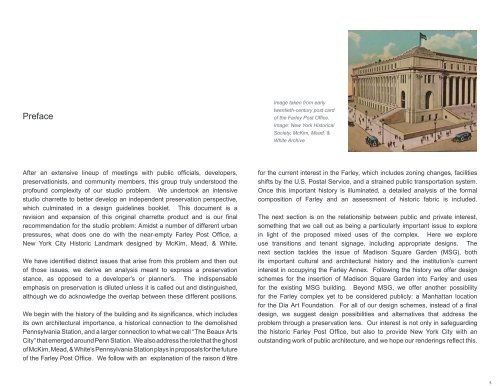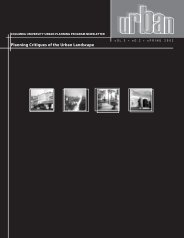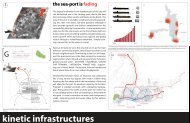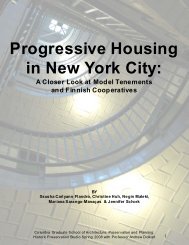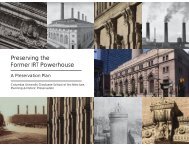Preservation of the Farley Post Office - Columbia University ...
Preservation of the Farley Post Office - Columbia University ...
Preservation of the Farley Post Office - Columbia University ...
Create successful ePaper yourself
Turn your PDF publications into a flip-book with our unique Google optimized e-Paper software.
Preface<br />
Image taken from early<br />
twentieth-century post card<br />
<strong>of</strong> <strong>the</strong> <strong>Farley</strong> <strong>Post</strong> <strong>Office</strong>.<br />
Image: New York Historical<br />
Society, McKim, Mead, &<br />
White Archive<br />
After an extensive lineup <strong>of</strong> meetings with public <strong>of</strong>ficials, developers,<br />
preservationists, and community members, this group truly understood <strong>the</strong><br />
pr<strong>of</strong>ound complexity <strong>of</strong> our studio problem. We undertook an intensive<br />
studio charrette to better develop an independent preservation perspective,<br />
which culminated in a design guidelines booklet. This document is a<br />
revision and expansion <strong>of</strong> this original charrette product and is our final<br />
recommendation for <strong>the</strong> studio problem: Amidst a number <strong>of</strong> different urban<br />
pressures, what does one do with <strong>the</strong> near-empty <strong>Farley</strong> <strong>Post</strong> <strong>Office</strong>, a<br />
New York City Historic Landmark designed by McKim, Mead, & White.<br />
We have identified distinct issues that arise from this problem and <strong>the</strong>n out<br />
<strong>of</strong> those issues, we derive an analysis meant to express a preservation<br />
stance, as opposed to a developer’s or planner’s. The indispensable<br />
emphasis on preservation is diluted unless it is called out and distinguished,<br />
although we do acknowledge <strong>the</strong> overlap between <strong>the</strong>se different positions.<br />
We begin with <strong>the</strong> history <strong>of</strong> <strong>the</strong> building and its significance, which includes<br />
its own architectural importance, a historical connection to <strong>the</strong> demolished<br />
Pennsylvania Station, and a larger connection to what we call “The Beaux Arts<br />
City” that emerged around Penn Station. We also address <strong>the</strong> role that <strong>the</strong> ghost<br />
<strong>of</strong> McKim, Mead, & White’s Pennsylvania Station plays in proposals for <strong>the</strong> future<br />
<strong>of</strong> <strong>the</strong> <strong>Farley</strong> <strong>Post</strong> <strong>Office</strong>. We follow with an explanation <strong>of</strong> <strong>the</strong> raison d’être<br />
for <strong>the</strong> current interest in <strong>the</strong> <strong>Farley</strong>, which includes zoning changes, facilities<br />
shifts by <strong>the</strong> U.S. <strong>Post</strong>al Service, and a strained public transportation system.<br />
Once this important history is illuminated, a detailed analysis <strong>of</strong> <strong>the</strong> formal<br />
composition <strong>of</strong> <strong>Farley</strong> and an assessment <strong>of</strong> historic fabric is included.<br />
The next section is on <strong>the</strong> relationship between public and private interest,<br />
something that we call out as being a particularly important issue to explore<br />
in light <strong>of</strong> <strong>the</strong> proposed mixed uses <strong>of</strong> <strong>the</strong> complex. Here we explore<br />
use transitions and tenant signage, including appropriate designs. The<br />
next section tackles <strong>the</strong> issue <strong>of</strong> Madison Square Garden (MSG), both<br />
its important cultural and architectural history and <strong>the</strong> institution’s current<br />
interest in occupying <strong>the</strong> <strong>Farley</strong> Annex. Following <strong>the</strong> history we <strong>of</strong>fer design<br />
schemes for <strong>the</strong> insertion <strong>of</strong> Madison Square Garden into <strong>Farley</strong> and uses<br />
for <strong>the</strong> existing MSG building. Beyond MSG, we <strong>of</strong>fer ano<strong>the</strong>r possibility<br />
for <strong>the</strong> <strong>Farley</strong> complex yet to be considered publicly: a Manhattan location<br />
for <strong>the</strong> Dia Art Foundation. For all <strong>of</strong> our design schemes, instead <strong>of</strong> a final<br />
design, we suggest design possibilities and alternatives that address <strong>the</strong><br />
problem through a preservation lens. Our interest is not only in safeguarding<br />
<strong>the</strong> historic <strong>Farley</strong> <strong>Post</strong> <strong>Office</strong>, but also to provide New York City with an<br />
outstanding work <strong>of</strong> public architecture, and we hope our renderings reflect this.<br />
5


